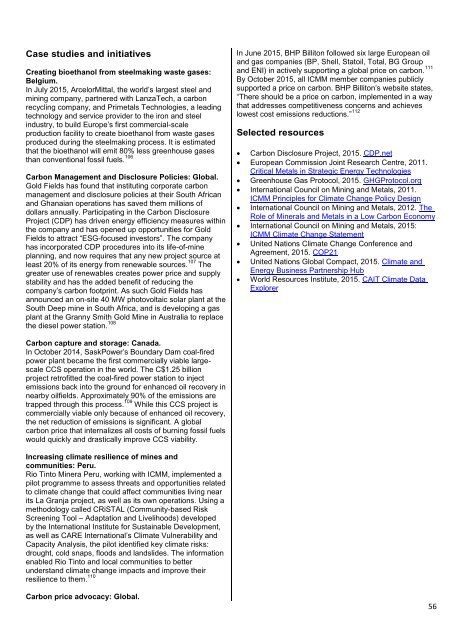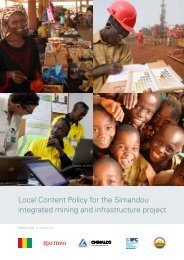Mapping Mining to the Sustainable Development Goals An Atlas
2gpArJN
2gpArJN
Create successful ePaper yourself
Turn your PDF publications into a flip-book with our unique Google optimized e-Paper software.
Case studies and initiatives<br />
Creating bioethanol from steelmaking waste gases:<br />
Belgium.<br />
In July 2015, ArcelorMittal, <strong>the</strong> world’s largest steel and<br />
mining company, partnered with LanzaTech, a carbon<br />
recycling company, and Primetals Technologies, a leading<br />
technology and service provider <strong>to</strong> <strong>the</strong> iron and steel<br />
industry, <strong>to</strong> build Europe’s first commercial-scale<br />
production facility <strong>to</strong> create bioethanol from waste gases<br />
produced during <strong>the</strong> steelmaking process. It is estimated<br />
that <strong>the</strong> bioethanol will emit 80% less greenhouse gases<br />
than conventional fossil fuels. 106<br />
Carbon Management and Disclosure Policies: Global.<br />
Gold Fields has found that instituting corporate carbon<br />
management and disclosure policies at <strong>the</strong>ir South African<br />
and Ghanaian operations has saved <strong>the</strong>m millions of<br />
dollars annually. Participating in <strong>the</strong> Carbon Disclosure<br />
Project (CDP) has driven energy efficiency measures within<br />
<strong>the</strong> company and has opened up opportunities for Gold<br />
Fields <strong>to</strong> attract “ESG-focused inves<strong>to</strong>rs”. The company<br />
has incorporated CDP procedures in<strong>to</strong> its life-of-mine<br />
planning, and now requires that any new project source at<br />
least 20% of its energy from renewable sources. 107 The<br />
greater use of renewables creates power price and supply<br />
stability and has <strong>the</strong> added benefit of reducing <strong>the</strong><br />
company’s carbon footprint. As such Gold Fields has<br />
announced an on-site 40 MW pho<strong>to</strong>voltaic solar plant at <strong>the</strong><br />
South Deep mine in South Africa, and is developing a gas<br />
plant at <strong>the</strong> Granny Smith Gold Mine in Australia <strong>to</strong> replace<br />
<strong>the</strong> diesel power station. 108<br />
In June 2015, BHP Billi<strong>to</strong>n followed six large European oil<br />
and gas companies (BP, Shell, Sta<strong>to</strong>il, Total, BG Group<br />
and ENI) in actively supporting a global price on carbon. 111<br />
By Oc<strong>to</strong>ber 2015, all ICMM member companies publicly<br />
supported a price on carbon. BHP Billi<strong>to</strong>n’s website states,<br />
“There should be a price on carbon, implemented in a way<br />
that addresses competitiveness concerns and achieves<br />
lowest cost emissions reductions.” 112<br />
Selected resources<br />
Carbon Disclosure Project, 2015. CDP.net<br />
European Commission Joint Research Centre, 2011.<br />
Critical Metals in Strategic Energy Technologies<br />
Greenhouse Gas Pro<strong>to</strong>col, 2015. GHGPro<strong>to</strong>col.org<br />
International Council on <strong>Mining</strong> and Metals, 2011.<br />
ICMM Principles for Climate Change Policy Design<br />
International Council on <strong>Mining</strong> and Metals, 2012. The<br />
Role of Minerals and Metals in a Low Carbon Economy<br />
International Council on <strong>Mining</strong> and Metals, 2015:<br />
ICMM Climate Change Statement<br />
United Nations Climate Change Conference and<br />
Agreement, 2015. COP21<br />
United Nations Global Compact, 2015. Climate and<br />
Energy Business Partnership Hub<br />
World Resources Institute, 2015. CAIT Climate Data<br />
Explorer<br />
Carbon capture and s<strong>to</strong>rage: Canada.<br />
In Oc<strong>to</strong>ber 2014, SaskPower’s Boundary Dam coal-fired<br />
power plant became <strong>the</strong> first commercially viable largescale<br />
CCS operation in <strong>the</strong> world. The C$1.25 billion<br />
project retrofitted <strong>the</strong> coal-fired power station <strong>to</strong> inject<br />
emissions back in<strong>to</strong> <strong>the</strong> ground for enhanced oil recovery in<br />
nearby oilfields. Approximately 90% of <strong>the</strong> emissions are<br />
trapped through this process. 109 While this CCS project is<br />
commercially viable only because of enhanced oil recovery,<br />
<strong>the</strong> net reduction of emissions is significant. A global<br />
carbon price that internalizes all costs of burning fossil fuels<br />
would quickly and drastically improve CCS viability.<br />
Increasing climate resilience of mines and<br />
communities: Peru.<br />
Rio Tin<strong>to</strong> Minera Peru, working with ICMM, implemented a<br />
pilot programme <strong>to</strong> assess threats and opportunities related<br />
<strong>to</strong> climate change that could affect communities living near<br />
its La Granja project, as well as its own operations. Using a<br />
methodology called CRiSTAL (Community-based Risk<br />
Screening Tool – Adaptation and Livelihoods) developed<br />
by <strong>the</strong> International Institute for <strong>Sustainable</strong> <strong>Development</strong>,<br />
as well as CARE International’s Climate Vulnerability and<br />
Capacity <strong>An</strong>alysis, <strong>the</strong> pilot identified key climate risks:<br />
drought, cold snaps, floods and landslides. The information<br />
enabled Rio Tin<strong>to</strong> and local communities <strong>to</strong> better<br />
understand climate change impacts and improve <strong>the</strong>ir<br />
resilience <strong>to</strong> <strong>the</strong>m. 110<br />
Carbon price advocacy: Global.<br />
56






